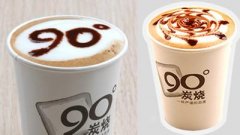Starbucks'"mysterious" coffee
Customers can have a comprehensive understanding of all the dishes and drinks that a store can offer by browsing the contents of the menu, and the higher-grade restaurants make the menu illustrated, so that customers can choose their favorite food at a glance.
In theory, the more items on the menu, the better. However, in the petty bourgeois Starbucks coffee shop, there is a coffee that has not taken a place on the menu after decades. What is the secret of this "mysterious" coffee?
What is the reason why this mini cappuccino is out of the menu? Starbucks' official explanation is that "there is no extra room on the menu", which is really surprising. Although in the eyes of ordinary people, whether the coffee is on the menu or not has little effect on them, economists have found a hidden mystery in it. You know, this mini cappuccino, which is not on the menu, is the key to Starbucks' way to make money.
Fully tap the potential of consumers
In fact, the 8-ounce cappuccino contains the same amount of espresso as the 12-ounce coffee listed on the menu, so a small cup of cappuccino with less water naturally has a stronger flavor. The World Barista Competition made it clear that a cappuccino tastes best at 5 to 6 ounces. However, the average customer always thinks that a small cup of coffee should be cheaper than a large one, regardless of the contents. At the same price of 8 ounces and 12 ounces, consumers always feel that they have lost money.
As customers have the mentality of "similar items, larger models must be more expensive and better", Starbucks is caught in a dilemma. If they want to launch this kind of small espresso and lower the price instead of raising the price, the profit of the coffee shop will be reduced and the loss will outweigh the gain; on the contrary, if the price of coffee is raised, it will lose a certain source of customs. this is what every business does not want to see.
For businesses, the best-case scenario is that those customers who have the spending power choose expensive goods without causing any waste of resources, while ordinary customers spend as much as they can afford. Starbucks' method of "watching people sell coffee" is to make the same coffee as profitable as possible without losing low-end customers.
As for how to judge whether a customer belongs to this category, it depends on the waiter's working experience for many years. Through careful observation, experienced waiters can easily judge whether guests can accept coffee with a strong, mellow taste, small capacity and high price. If you judge that the customer can accept it, then privately recommend the mini cappuccino, otherwise recommend the oversized cappuccino. In this way, Starbucks can easily get rid of the dilemma that price cuts will reduce marginal profits, while price increases will lose customers and make itself in an "invincible position".
Important Notice :
前街咖啡 FrontStreet Coffee has moved to new addredd:
FrontStreet Coffee Address: 315,Donghua East Road,GuangZhou
Tel:020 38364473
- Prev

Top Coffee Nest Vows to Be the First Brand of Coffee in China
The United States has "Starbucks", the United Kingdom has "COSTA", and the Chinese own coffee brand is called "Coffee Nest"!
- Next

Yunnan Hougu Coffee Plantation
The research and development of a new variety of plantation coffee (Bobang Tippica) introduced Kenyan coffee variety K7 to study its characteristics of drought resistance and cold tolerance. Through planting and screening in different local environments, the high quality K7 varieties with cold resistance, low temperature tolerance, pest resistance and high yield were finally selected. High-altitude coffee planting research and development of coffee hanging fruit scene of ten thousand mu coffee base prospect picture of ten thousand mu coffee forest close range country
Related
- What brand of black coffee is the most authentic and delicious? what are the characteristics of the flavor of the authentic Rose Summer Black Coffee?
- Introduction to the principle and characteristics of the correct use of mocha pot A detailed course of mocha pot brewing coffee is described in five steps.
- Which is better, decaf or regular coffee? how is decaf made?
- How much is a bag of four cat coffee?
- How about four Cat Coffee or Nestle Coffee? why is it a cheap scam?
- Which is better, Yunnan four Cats Coffee or Nestle Coffee? How about cat coffee? is it a fake scam? why is it so cheap?
- How about Cat Coffee? what grade is a hoax? which instant coffee tastes better, four Cat Coffee, Nestle Coffee or G7 coffee?
- Process flow chart of coffee making-Starbucks coffee making process what coffee tastes good at Starbucks
- The top ten best coffee beans in the world Rose summer coffee or Tanzanian coffee tastes good
- Yunnan four cat coffee is good to drink?_four cat coffee is a big brand? four cat blue mountain coffee is fake?

